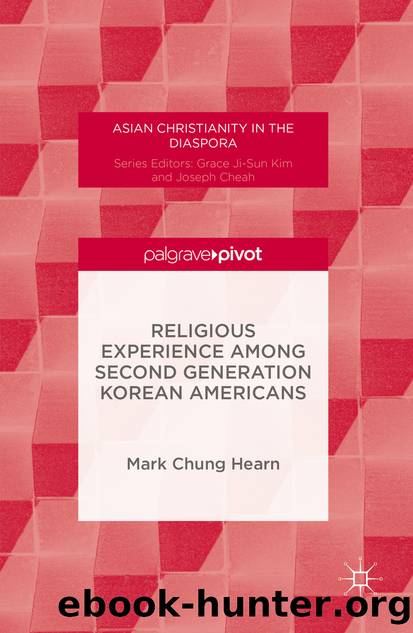Religious Experience Among Second Generation Korean Americans by Mark Chung Hearn

Author:Mark Chung Hearn
Language: eng
Format: epub
Publisher: Palgrave Macmillan US, New York
Post-1965 Korean American Churches
As the discussion moves away from the early Korean American church to a post-1965 period, it is important to understand the roles the church has played according to the historical and social milieu in which it has existed. One might say that, while the Korean American church still plays a political role, it addresses matters contextually. For instance, as early immigrants viewed the church as an independence-gaining institution, there are those who view reunification between North and South Koreas as a focus need of the contemporary church. 8 On the contrary, there are those of the second generation who, following the lead of white evangelicalism , believe the church should exist apolitically. 9 To interpret the roles of the Korean American church contextually then is to note that the perceived needs of the Korean American community are partially informed by the different generations. The internal diversity of Korean Americans prohibits us therefore, from making definitive claims about the Korean American church.
Keeping in mind the caveat to over generalize, contemporary works on Korean American Christianity however, provide a few possibilities for identifying preliminary themes and patterns. The issues of race, ethnicity, and discrimination and the negotiation of these by Korean Americans in their religious, civic , and social lives is one possible theme. 10 Antony Alumkal argues that a study of religion through the lens of race yields two responses on account of differing denominational and theological affiliation in Asian American churches. 11 On the one hand, Asian American churches influenced by American evangelicalism often frame the discussion of race in terms of unity and oneness in Christ. The âhomogeneous unit â becomes the overriding principle through which to view differences such as race and consequently cover over these differences in the name of unity. 12 On the other hand, mainline Asian American churches are more apt to view race and ethnicity as essential to oneâs religious identity; each is equally vital to the construction of oneâs identity and must be seen as aspects to be embraced. 13
A second theme that appears to emerge consists of the notion surrounding ideas of agency , hybridity , and creativity. 14 The jazz term âimprovisation â captures this idea best as it demonstrates Korean Americansâ ability to maneuver and create using the parts they have despite the changing contexts in which they often exist. 15 Korean Americans continue to create and act as agents despite family, financial, and bicultural difficulties that cause unstable realities. Sharon Kim âs longitudinal study of twenty-two second-generation Korean American churches offers support for this hypothesis. Kim argues that second-generation Korean American churches in the Los Angeles area are creating âhybrid third spacesâ as ways to hold their ethnic and cultural heritages while not being limited by them. 16 In this hybrid third space, Korean Americans negotiate multicultural and multiracial differences on account of Christianity and resist either assimilationist or pluralist theories that suggest they need to be one (Korean or American) or both (Korean and American), but not some emerging formation between the two (Korean American).
Download
This site does not store any files on its server. We only index and link to content provided by other sites. Please contact the content providers to delete copyright contents if any and email us, we'll remove relevant links or contents immediately.
Christian Ethics for a Digital Society by Kate Ott(724)
Fearfully and Wonderfully Made by Philip Yancey & Paul Brand(704)
The World from 1450 To 1700 by Wills John E.;(655)
God and the Multiverse by Victor J. Stenger(614)
Numbers by Ronald B. Allen(578)
How to Read Slowly by James W. Sire(560)
Christian Ethics: An Introduction to Biblical Moral Reasoning by Wayne Grudem(557)
Morality by Jonathan Sacks(511)
Monastic Archaeology by Unknown(494)
The Technological System by Jacques Ellul(482)
The Disabled Church by Rebecca F. Spurrier;(470)
Jesus: A New Vision by Whitley Strieber(467)
Amish Grace by Donald B. Kraybill & Nolt Steven M. & Weaver-Zercher David L(466)
Children of Lucifer; The Origins of Modern Religious Satanism by Ruben van Luijk(458)
Death of the Doctor by Unknown(451)
Critical Writings by Joyce James;(450)
Redeeming Sociology by Vern S. Poythress(440)
The City of God by Saint Augustine & Marcus Dods(438)
The Church in the Early Middle Ages by G.R. Evans(421)
